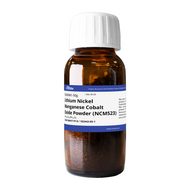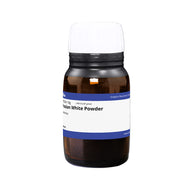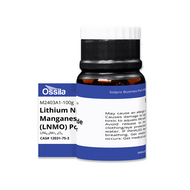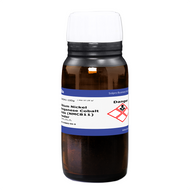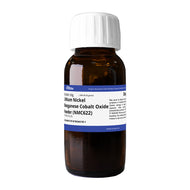Cathode Active Materials
Cathode active materials (CAMs) are a key component in any battery. In the rapidly evolving world of energy storge, our high purity metal oxides meet the increasing demand for reliable, safe, and affordable battery technology. Our selection of cathode active materials includes the six main types for lithium-ion batteries: LFP, LMO, LCO, NMC, NCA, NCM, as well as the newer LNMO and LMFP.
As the source of lithium ions, CAMs play a direct role in lithium-ion exchange and are required in large quantities. Beyond lithium-ion systems, we also supply metal oxides for sodium-ion, zinc-ion, nickel-based, and solid-state batteries, offering a wide variety of electrochemical properties. These properties depend on factors such as structure, oxidation states, and metal combinations, enabling alternative chemistries to complement and diversify beyond the popular lithium-ion battery.
Key Features and Applications
- Different multi-metal oxide material composition offers varied characteristics:
- Manganese, cobalt and iron for safety - Lithium Nickel Manganese Cobalt Oxide (NMC), Lithium Iron Phosphate (LiFePO4)
- Nickel for high capacity - NMC, Lithium Nickel Cobalt Aluminum Oxide (NCA)
- Aluminum for high power - NCA
- Lithium cobalt oxide (LCO) and lithium iron phosphate (LiFePO4 / LFP) known for their high specific and volumetric energy density.
- Ternary oxide lithium nickel manganese cobalt oxide (NMC) has displayed great advantages with relatively high energy density, low cost, low toxicity, and cycle stability.
- Metal oxides such as manganese oxide and nickel oxide are cathode active materials found in different battery chemistries such as zinc-ion batteries and primary alkaline batteries.
- Prussian blue analogue and Prussian white form one of the most promising families of cathode materials for large-scale, low-cost sodium-ion energy storage applications.
Jump to: Browse Cathode Active Materials | Choose the Right Battery Material | Resources and Support
Browse Cathode Active Materials
Related categories: battery materials, anode active materials, inorganic electronic materials, metal oxides, sodium-ion battery materials
Filter by price change:
Filter by battery type:
Choose the Right Cathode Active Material
It is important to consider the application of the battery when deciding on the right cathode active material for your research. Each material has a different chemical composition and structure which is designed to benefit the different properties of a battery. These properties can range from increased ion mobility to allow for faster charging/discharging, to increased chemical stability to enhance cycle life.
Cathode Active Materials by Properties
| Battery Material | Voltage (V) | Specific Capacity (mAh/g) | Cycle Life |
|---|---|---|---|
| NCA | 4.7 V | 194 | 500 Cycles |
| LNMO | 4.7 V |
146.8 (Theoretical) 103 (Experimental) |
92% retention after 1000 cycles |
| NCM523 | 4.3 V | 154 | 76.9% retention after 400 cycles at 3C |
| LiCoO2 | 4.0 – 4.2 V |
274 (Theoretical) 165 (Experimental) |
500 – 1000 Cycles |
| LMO | 4.0 V | 105 | 300 – 700 Cycles |
| NMC811 | 3.8 V | 200 | 1000 – 2000 Cycles |
| LiFePO4 | 3.2 V | 155.5 | ~ 1500 Cycles |
Cathode Active Materials by Application
| Hybrid Electric and Electric Vehicles | Energy Storage and Renewable Energy | Consumer Electronics | Power Tools | |
|---|---|---|---|---|
Resources and Support
The NCA battery gets its name from the cathode active material, lithium nickel cobalt aluminum oxide (LiNixCoyAlzO2, where x+y+z=1) which gets shortened to nickel cobalt aluminum (NCA). NCA is the cathode active material with a specific ratio of metals.
Learn more...An LFP battery gets its name from it’s key material component, lithium iron phosphate powder, which has the chemical formula LiFePO4. It is also known as lithium ferro phosphate which gets shortened to LFP, hence the name.
Learn more...LMFP stands for lithium manganese iron phosphate, a material used in the cathode of lithium-ion batteries. With the molecular formula LiMnxFe(1-x)PO4 it has the same crystal structure type as lithium iron phosphate (LFP), another popular cathode material.
Learn more...A ternary lithium battery is a type of lithium-ion battery (LIB) that has a cathode composed of three different metals. The metals are nickel (Ni), cobalt (Co), manganese (Mn) or aluminium (Al).
Read more...Solid-state batteries (SSBs) differ from conventional lithium-ion batteries (LIBs) in terms of both their components and fundamental design features. Instead of a liquid electrolyte, they use a solid electrolyte to conduct lithium ions between electrodes.
Learn more...Lithium-polymer (LiPo) batteries are a type of lithium-ion battery technology that uses polymer electrolytes. This differs from standard lithium-ion batteries which use a solvent based electrolyte. Polymer electrolytes used are highly ionically conductive and form lithium-ion conduction channels.
Learn more...Internal resistance of a battery is one indicator of a battery’s current-carrying capacity. There is an inverse relationship between the two parameters.
Learn more...Lithium-ion (Li-ion) batteries can catch fire due to a process known as thermal runaway, which is triggered by various factors and involves a series of heat-releasing reactions. While Li-ion batteries are widely used in laptops, cameras, and electric vehicles (EVs) such as scooters and cars, their rise in popularity has not been without issues. In the UK alone, fire services responded to 921 lithium-ion battery fires in 2023, a 46% increase from the previous year.
Learn more...

